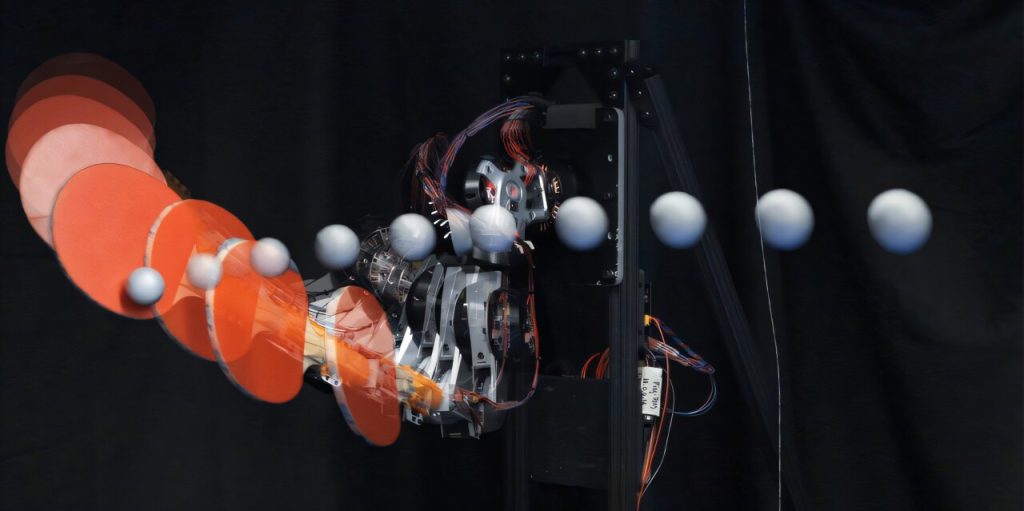
MIT engineers have taken table tennis to a new level with the creation of a high-speed ping pong robot.
This impressive machine is designed to hit the ball back with exceptional speed and accuracy, rivaling even skilled human players.
Equipped with a robotic arm fixed to one end of a standard ping pong table, the bot uses a regular ping pong paddle to return shots with different styles, including loops, drives, and chops.
Unlike older robotic designs, this one is remarkably quick and precise, thanks to a combination of high-speed cameras and advanced predictive control systems.
The secret behind its success lies in the robot’s ability to quickly estimate the speed and path of the ball as it approaches.
With just a split second to react, the robot determines the best swing type and executes it flawlessly, hitting the ball back to a specific spot on the table.
During testing, engineers fired 150 balls at the robot, one after the other.
The bot returned 88% of them with perfect timing and spin. Its strike speed even matches the top speeds of human players, making it one of the fastest ping pong robots ever built.
The team at MIT is not stopping there.
They are working on expanding the robot’s range of movement, hoping to allow it to cover a larger area of the table and handle a wider variety of shots. If successful, this upgrade could transform the robot into a strong competitor in the growing field of smart training systems.
In the future, players might be able to practice with this robot to sharpen their skills, facing off against a machine that can mimic real opponents with incredible accuracy.
But the implications of this technology go beyond just table tennis. The researchers believe that the skills developed for the ping pong robot could be adapted for more significant applications, such as humanoid robots for search-and-rescue missions.
These robots would need to react quickly and accurately in unpredictable environments, much like the ping pong robot does when returning a fast-moving ball.
David Nguyen, one of the MIT graduate students working on the project, says that the quick interception skills being honed through this robotic arm could be life-saving in real-world scenarios where rapid response is crucial.
Nguyen co-authored the study along with fellow MIT student Kendrick Cancio and Sangbae Kim, the head of the MIT Biomimetics Robotics Lab.
They plan to present their findings at the IEEE International Conference on Robotics and Automation (ICRA) later this month. Their research has already been published on the arXiv preprint server, sharing their work with the global scientific community.
Building robots that can play ping pong is not a new idea. Researchers have been experimenting with this challenge since the 1980s. It requires the perfect blend of fast machine vision, precise motor control, and quick decision-making.
Most robotic arms are either very good at slow, careful movements, like picking up objects, or rapid movements like running. Ping pong, however, demands both precision and speed. Nguyen explains that the game sits right in the middle of those two extremes, requiring both precise manipulation and quick, dynamic movement.
Other companies, like Omron and Google DeepMind, have also explored ping pong robots, some of which use artificial intelligence to learn and improve their performance over time.
However, MIT’s approach focuses more on mastering the physical mechanics of the game through real-time motion tracking and predictive control rather than just learning from past matches.
To make their robot a true ping pong master, the MIT team added a fifth joint to the robotic arm, giving it more flexibility and control over paddle movement.
They also placed high-speed motion-capture cameras around the table to track the ball’s trajectory.
Using advanced algorithms, the system calculates exactly how fast and at what angle the arm should swing to return each shot perfectly. In their experiments, the robot achieved impressive results, with strike speeds reaching up to 19 meters per second, just shy of what top human players can achieve.
Looking ahead, the team plans to mount the robot on a movable platform so it can cover more of the table.
This would allow it to handle trickier shots and become an even better training partner. According to Cancio, the next step is teaching the robot to predict the spin and trajectory of the ball based on the opponent’s moves, making it a truly formidable practice partner.
With each update, MIT’s ping pong robot is coming closer to mimicking real human play. One day, it might not just be a training tool but a true competitor, pushing the boundaries of what robots can do in sports and beyond.
Source: MIT.

